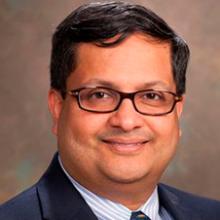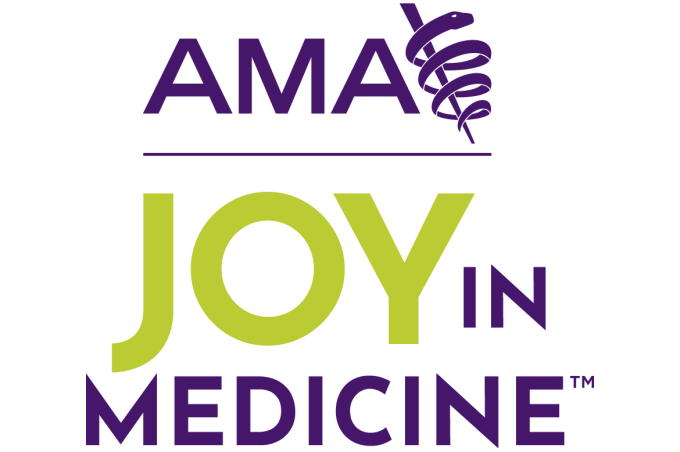Just as the COVID-19 public health emergency was hitting U.S. shores in 2020, Geisinger was poised to use a new robotics automation tool to reduce work hours and improve efficiency across its regional footprint in Pennsylvania.
“We have a substantial amount of investment in robotic process automations,” Narayana Murali, MD, Geisinger’s chief medical officer for medicine services, said during an AMA webinar on value-based care and technology’s role in driving its success.
Geisinger is a member of the AMA Health System Program, which provides enterprise solutions to equip leadership, physicians and care teams with resources to help drive the future of medicine.
Under this process, computer software generates a robot that adopts human ways of interacting within digital systems to execute a business process. The bot “works through all the different areas that we need to focus on in terms of achieving efficiency and outcomes,” said Dr. Murali.
The first bot in Geisinger’s Intelligent Automation Hub went live in December 2019. In 2020, the health system’s 21 automations and 20 bots were working across 31 business lines, processing COVID-19 and other viral test results, exposure notifications, vaccine billing for Medicare Advantage and data reporting for state health agencies.
From April 2020 to October 2021, this translated to about 900,000 digital hours worked during the COVID-19 public health emergency. By 2022, the program had grown to about 80 automations and more than 100 bots, including chatbots and low-code applications—created using a low-code development platform, which allows users to build apps with minimal coding—to improve efficiency. All of that work would have taken the equivalent of 430 full-time human workers to complete over the same time period.
Geisinger saved about $40.5 million during this period. But this isn’t just about dollars and cents, he emphasized. It’s about investing in technology to improve value, efficiency, compliance, regulatory elements and audits. Most importantly, technology can improve the care-experience that patients have and the quality of care they receive.
Other augmented intelligence (AI) tools at Geisinger have improved care for key populations, increasing patient access, achieving improved clinical outcomes and reducing health care costs. During the webinar, Dr. Murali discussed how Geisinger uses AI to streamline care coordination, optimize physician resources and detect early-stage disease.
1,000-foot view on value-based care
Based in Danville, Pennsylvania, Geisinger comprises 10 hospital campuses and 133 primary and specialty clinics and employs more than 1,700 physicians. Its health plan covers 600,000 patients through commercial and government plans while 80% of the population lives in value-based care programs. In 2023, Geisinger earned more than $45 million in total annual financial incentives through its value-based care arrangements, according to an AMA case study (PDF).
“We are one of the largest integrated delivery networks in the country,” said Dr. Murali, noting the health plan works hand in hand with the clinical enterprise to assess what’s in the best interest of the patient from a quality standpoint.
Geisinger has sought to achieve these goals by participating in the Keystone Accountable Care Organization (ACO) which provides coordinated health care services to more than 80,000 Medicare patients in Pennsylvania. Through Keystone, Geisinger is a participant in the Medicare Shared Savings Program (MSSP), which rewards health care organizations for lowering costs and improving patient care. In 2025, Geisinger will be taking part in the enhanced-risk track for MSSP.
“We are proud to have been named in Becker's Hospital Review as one of the top ACOs twice,” said Dr. Murali, noting that since 2019, Geisinger has saved more than $225 million from the ACO perspective.
“That's about 45,000 Medicare lives that involve partnerships with 11 medical groups and the hospitals that we provide service in our footprint,” he said.
Geisinger also participates in Medicare’s Bundled Payments for Care Improvement program and has a behavioral health joint venture that provides inpatient and outpatient health care.
AI helps target care management
The AMA case study also highlights several areas in which Geisinger uses AI to support value-based care. One of these is population health. A risk-stratification model helps identify patients with chronic disease who are at high risk for hospitalization. Geisinger gives these patients access to care management, and using this risk-stratification model has reduced avoidable emergency department visits and hospital admissions among patients with chronic conditions by 10%.
At least 400 projects to improve efficiency and outcomes with a specific intervention rely on technology to provide patient care. Dr. Murali mentioned several that target common forms of cancer.
Physicians and their care teams must screen about 154 patients to find one person with colorectal cancer. Geisinger uses a predictive algorithm that employs AI to track and identify 2.7% of those 50,000 people at the highest risk for colorectal cancer. This requires a screening process as well as a care team to contact these patients.
“Some of them obviously decline colorectal screening. Some are not easy to reach. But 54% of those identified patients did go through an intervention,” Dr. Murali reported.
This raises the odds of detecting colorectal cancer from one in 154 to one in 13, resulting in “freed up physician time to manage patient care in a much more effective manner.”
From AI implementation to EHR adoption and usability, the AMA is fighting to make technology work for physicians, ensuring that it is an asset to doctors—not a burden.
Use tech to find high-risk nodules
Dr. Murali also highlighted Geisinger’s System to Track Abnormalities of Importance Reliably (STAIR) program, which uses natural language processing to screen radiology reports and optimize follow-up care and treatment for patients with incidental lung nodules.
Among the 5 million computed tomography (CT) scans performed across the country each year, about 1.5 million have a lung nodule, an abnormality that calls for a follow-up. Only a small proportion of those nodules—about 60,000—translate to cancer or a malignancy.
“However, if you are trying to get an appointment for the 1.5 million lung nodules with a pulmonologist or a pulmonary critical care person, there are only about 5,500 pulmonologists in the country available,” said Dr. Murali. “If you really look at that 60,000 cases that turn into cancer, 50% of those cases are lost for follow-up across the country.”
Geisinger uses STAIR’s natural language processing technology and other enrollment channels to identify patients whose nodules on radiology scans are at highest risk for bad outcomes. Once the patient is enrolled in STAIR, specialized pulmonology advanced practitioners develop a plan of care that’s shared with the patient and their referring physicians. Clinic visits only take place when needed—however, the enrolled patients are monitored to ensure they don’t miss follow-up appointments.
“We started tracking those patients with our coordinators. Now we've had zero missed malignancies,” said Dr. Murali.
The program has improved management of chronic disease. It used to take 112 days from when a lung nodule was discovered until the patient got a follow-up visit. With STAIR, Geisinger has cut that wait to just eight days. On top of that, 94% of the 9,282 patients enrolled to date did not require a clinic visit. With a greater than 90% program-completion rate, 9% of patients are diagnosed with lung cancer, with the majority at a curable stage.
What drives technology
Investing in a digital analytics hub starts with managing cost and utilization, care management and coordination, and patient experience, as well as engaging physicians and care teams, said Dr. Murali.
“We are really focused on quality from the standpoint of outcomes, caring and experience, and then trying to identify accurately the attribution of the population that we need to improve, and then risk adjusting and stratifying them,” he said.
Through its relationship with Risant Health—a nonprofit organization Geisinger launched with Kaiser Permanente in 2023—Geisinger anticipates adding more value-based platform tools into its services.
Ultimately, this is about people, process and technology. “Technology is not the driver,” Dr. Murali said. Instead, it has to be incorporated into all processes, along with the people who inspire and engage in providing the service.
Learn more with the AMA about value-based care, including ways to improve data sharing and best practices for payment methods.





